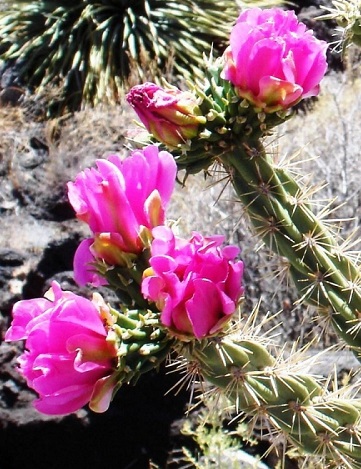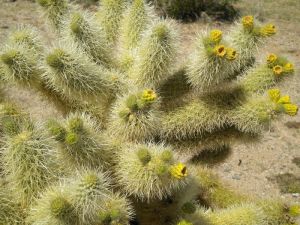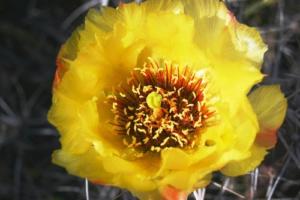Cylindropuntia and Corynopuntia

Updated September 2020
Cholla is the common name applied to the cylindrically stemmed opuntiad cacti of the southwestern United States and Mexico. This site describes the chollas of the United States, which include Cylindropuntia and Corynopuntia (Grusonia), and Micropuntia. Cylindropuntia species are genetically and morphologically distinct from Corynopuntia species, although they have historically been lumped under the common name, cholla.
Cylindropuntia and Corynopuntia comprise two of the three major opuntiad groups in the United States. The other major group, Opuntia (prickly pears), is described at our sister website, Opuntia Web.
The Details
Chollas have cylindrical stems, in contrast to the flattened stems of the Opuntia. However, chollas are similar to prickly pears in many ways, including their jointed stems, possession of glochids, and seeds with hard outer protective surfaces (arils).
Cylindropuntia

Cylindropuntia species take a variety of forms, from small shrubs to trees. They have spines that are covered with papery sheaths that fall off with age. They generally have a sprawling to erect habit, though they can take on a somewhat matted effect when animals burrow beneath them, causing the stems to collapse and reroot. The tree-like Cylindropuntia species, such as Cylindropuntia acanthocarpa and C. munzii, can grow to 15-ft tall or more. Cylindropuntia species, like Opuntia species, hybridize sparingly within the genus. However, there are no known intergeneric hybrids, either natural or man-made, among Opuntia, Cylindropuntia, or Corynopuntia.
Corynopuntia

Corynopuntia are similar to Cylindropuntia in many ways, but they have short stems that grow along the ground in a matted or clumped form with no distinct trunk. The joints of Corynopuntia are clavate (club-shaped), meaning they are wider at the top than the bottom. The spines of Corynopuntia are flattened rather than round, and the papery sheaths on the spines cover only the tips of the spines rather than the entire length of the spines as in Cylindropuntia.
Like Cylindropuntia, Corynopuntia was formerly placed in the genus Opuntia. The taxonomic status of Corynopuntia is still under study, and it currently appears likely that research will support the division of these so-called “dog chollas” into at least three genera: Corynopuntia, Grusonia, and Micropuntia.
What We Do
We describe the various species and provide photographs so you can see details. The goal is to show you what these plants look like and to describe them in easily understood terms. A group of editors verifies all the information on this website, and we strive to present accurate information. We’ve traveled to many places to photograph chollas, and we have visited libraries to find relevant printed information.

I would like to cite your website – what is the best way to do that? Who would the authors be?